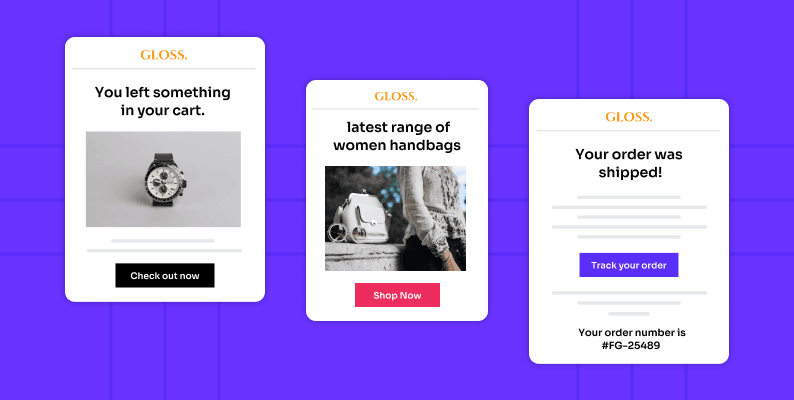Email marketing is a crucial component of any direct-to-consumer (DTC) brand’s communication strategy.
It’s not enough for your DTC brand to rely completely on social media, digital marketing, or PPC marketing alone.
You have better control over your email list which helps you form lasting relationships, increase customer engagement, and boost sales. But which types of emails the DTC and Ecommerce brands should send out to nurture and convert customers?
In this guide, you’ll see the best DTC email marketing campaign examples that will help you lay the foundation of your DTC and Ecommerce email marketing strategy.
Let’s begin!
What is an email marketing campaign and why is it important?
A series of automated and coordinated emails that brands send to their email subscribers across a specific period of time with a specific intention is called an email marketing campaign. Each email in a campaign has a specific purpose and a definite call to action (CTA), making it an effective DTC growth strategy.
Some benefits of sending email marketing campaigns to your subscribers are:
- Attract new customers – You can increase leads and sales of your business by sending them welcome emails that introduce your Ecommerce business to them. Offer them exclusive and limited-time offers, discounts, new arrivals, and giveaways.
- Retain current customers – You can personalize your emails, create segmented lists, and change your subject lines to increase engagement and retain customers.
- Build brand awareness – They help your DTC brand remain on top of customers’ minds due to their personalization and high optimization over long-term interactions with customers.
- Nurture leads – By sending the right educational and promotional material to your subscribers, you can move them down the sales funnel and convert them into buying customers. Prime them for seasonal promotions, Black Friday sales (BFCM strategies), new product launches, and other sales.
You can use email campaign software or tools to send automated email marketing campaigns.
10 Types of email campaign examples from the best DTC brands
You can send many types of emails to your email subscribers. The type of email marketing campaigns you send completely depends on your goals.
Let’s deep dive into some of the most important types of email marketing campaign examples that will give you many email marketing content ideas for your DTC brand.
1) Clearance sale email from Soak&Sleep
As an Ecommerce or DTC retailer, you need to clear last season’s unsold stock to make way for your new collections. If you’re planning a clearance sale, then target both your existing customers as well as prospects.
Clearance sales can be a highly effective marketing strategy that attracts your customers as well as the bargain-hunters in your email list.
A clearance sale should last for a limited time and use a blend of scarcity with discounts to drive purchases.
Caveat – But don’t give heavy discounts too often disguised as clearance sales as your customers will be reluctant to buy without heavy discounts.
Instead, you should heavily promote clearance sales through email marketing campaigns and have customers reaching out to you.
Get Lifesight’s email and SMS Templates.
Example
Take the example of the online bed and bath online brand and retailer Soak&Sleep.
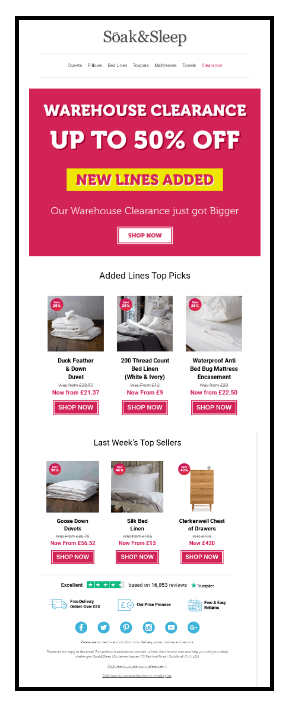
They have kept their clearance sale email simple. Its email copy is crystal clear.
- It highlights a discount of upto 50% off to create desire.
- There is a clear visual presentation that includes photos of products on sale.
- There is a ‘shop now’ CTA button that takes the customer directly to the online store.
This is a clear example of Ecommerce email marketing used wisely to sell old stock to a receptive audience.
2) Shipping notification email from Vuori
Perhaps one of the most exciting transactional emails a customer can receive is the shipping notification email. These trigger-based emails are sent once the product has been shipped.
Think of it as an opportunity for your brand to communicate with customers to inform them that their products have been shipped and provide them with a tracking link or code to check the status.
The email recipient doesn’t need to be an email subscriber to receive these emails. Anyone who has made a purchase by sharing their email id receives them.
They provide you an opportunity to get creative and build more engagement as the customer is already primed to buy from you, improving your retention. So, use this opportunity as a part of your Ecommerce hyper-personalization strategy to personalize the CTA according to the customer’s purchase. For example, you could recommend products that match the recent purchase or introduce them to a referral or rewards program.
Example
Vuori is an athletic clothing and activewear brand that sends out shipping notification emails. This email is a great example of how brands can provide an impeccable user experience while providing valuable information.
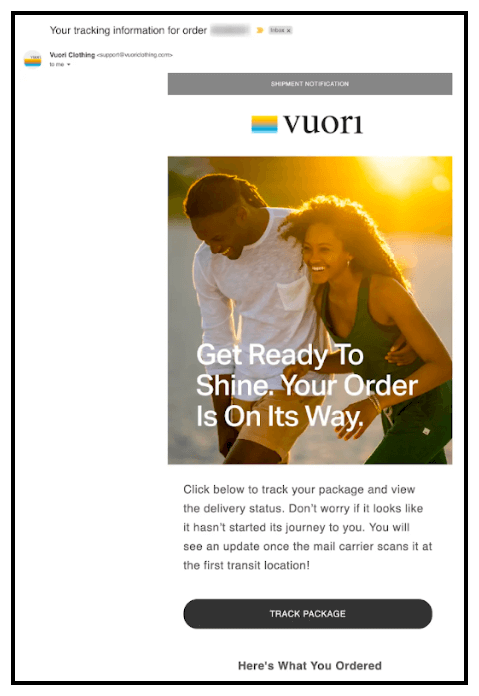
Several things are good about this email:
- The subject line “get ready to shine, your order is on its way” makes the recipient feel good.
- It includes images and product details of their purchases.
- A prominent ‘track package’ button.
- Clear information about returns, frequently asked questions (FAQs), and stores.
- Maintains its brand voice and talks directly to email recipients.
Tip – The above example shows how your DTC brand’s emails could reflect your unique tone. Also, your emails could talk directly to the recipient while focusing on user experience and providing valuable information.
3) Order confirmation email from Dollar Shave Club
Customers expect the order confirmation email after they make purchases. What’s more, it is an insanely useful sales tool that has the highest open and click-through rates in the Ecommerce space and 4x that of promotional newsletters.
Your Ecommerce and DTC emails should answer the basic questions about the order like:
- Expected date of the receipt of the order
- Address the order is being shipped to
- How customers can get in touch in case of issues or queries
Example
Dollar Shave Club, the DTC brand that delivers razors and men’s grooming products, is widely popular for its marketing campaigns. The first thing you would notice here is how the confirmation email has tons of visuals, making the email easy to scroll through.

The email immediately stands out:
- Its wood board design is attention-drawing and on-brand.
- In the beginning, they welcome the customer to the ‘club’ and ask them to review their transaction.
- They answer all the basic questions that form part of the order confirmation email.
- They even provide a bonus for referring a friend to the club.
Tip – Like Dollar Shave Club, your confirmation email could feature the products the customer just bought with its image, the customer’s address, the option to make changes, and the expected delivery dates.
4) Abandoned cart email from Levis
Many new and repeat customers login to your site, add items to their cart and leave without completing their purchase.
The average shopping cart abandonment rate ranges from 60% to 85% which translates to a huge revenue opportunity loss. Sending abandoned cart email campaigns to them can help you recover 15% of the revenue that would have been lost otherwise.
Ecommerce cart abandonment emails can be of two types:
- Abandoned cart emails are usually sent within one day of the cart being abandoned and remind customers of the items lying in their carts.
- Abandoned cart email series are triggered emails sent to customers for completing their purchases. The follow-up emails are usually sent within 3-5 days of the initial cart abandonment email.
You can add incentives for completing purchases like free shipping or additional discounts.
Example
Take a look at the cart abandonment email example from the popular denim brand Levi’s.
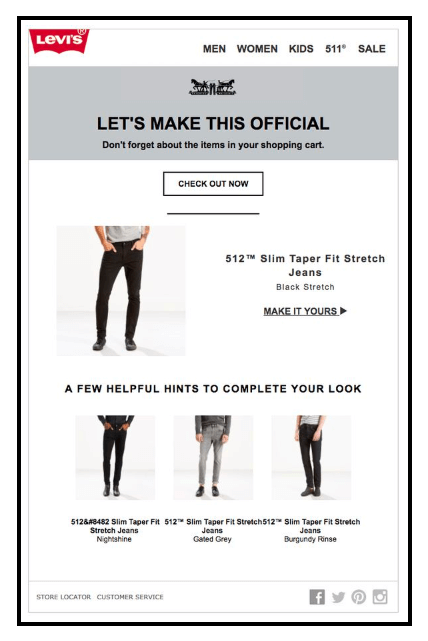
Here’s why this email stands out:
- The email is simple and straightforward that entices the customer to click on the ‘shop now’ button to purchase the items left in the cart.
- Levi’s email marketing strategy adds recommendations based on the products you added to the cart, to increase the average order value.
Tip – Levi’s refrains from using too much copy in its emails. Yet, it works well. If you are a fan of simplicity and minimalist design, try simplifying abandoned cart emails the way Levi’s does.
5) Engagement email campaign from POPFLEX
You’ve painstakingly created your email list but it gets depressing to see engagement metrics going down when recipients don’t open your emails.
Add to that the fact that a large percentage of unopened emails indicate to your email client to send future emails to the spam folder. That’s why it’s necessary to get your subscribers to engage with your emails to reduce churn.
Example
Case in point is what POPFLEX does in this re-engagement email. First of all, it starts with a dramatic subject line that catches the reader’s attention.
Subject Line: This is the last email you’ll ever see..
What follows next is a simple email copy explaining that POPFLEX has removed the recipient from its email marketing list.
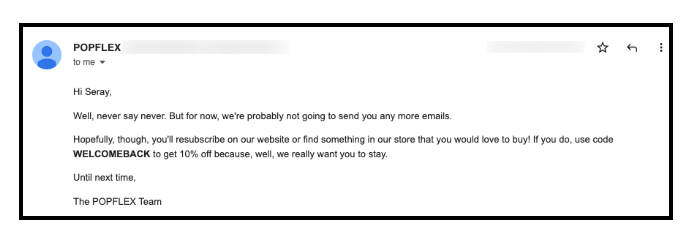
Why did we add this example to our list of DTC email campaigns?
- It doesn’t close the doors for the reader forever and makes it clear that it really wants the customer to come back.
- Also, it offers a discount code if customers ever find themselves returning back to the website to purchase.
- Remember, it is a good strategy to clear your email list of disengaged subscribers.
Caveat – Sending discounts in the re-engagement emails is a tricky Ecommerce email marketing strategy. Ideally, you should use it as a last-ditch approach when everything else has failed.
6) Scarcity email campaign from Fabletics
Using scarcity in your email campaigns to generate interest and sales works well for DTC brands. These email campaigns use captions like ‘low-in-stock, last chance, and almost gone’ to create scarcity and trigger customers’ fear of losing out on an opportunity FOMO.
Not wanting to miss out on the opportunity is probably one of the biggest motivators driving sales and conversions. What’s more, you can even personalize these bulk emails for Ecommerce.
Example
Fabletics is an athletic apparel brand offering high-quality and stylish workout clothes. They create scarcity by using numbers in their scarcity email campaigns.
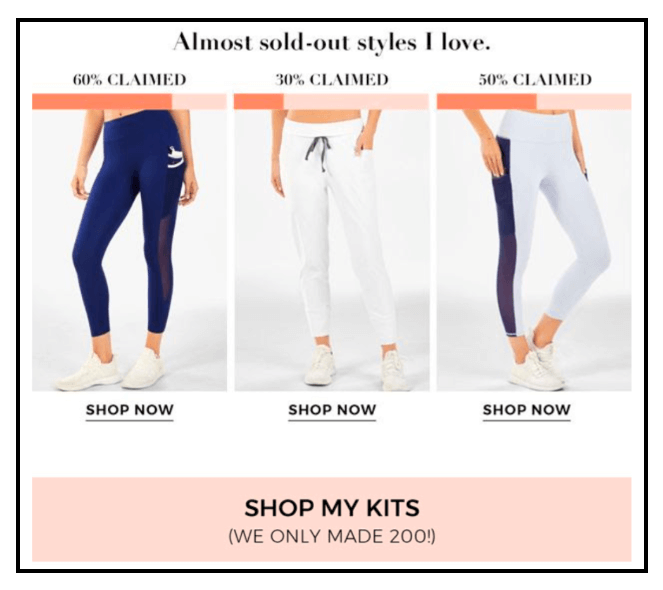
It is the perfect example of creating scarcity with psychological triggers in its emails. It stands out because:
- Using numbers nudges the customer to purchase quickly.
- They clubbed scarcity with products that customers love for more impact.
- The scarcity of product messaging is used in the email copy multiple times.
Tip – You can create exclusivity for your DTC products by calling some product categories “ultra-limited edition” in your email campaigns.
7) Win-back email campaign from Glossier
Win-back email campaigns focus on building a stronger bond with the customer that results in re-engagement and customer loyalty to your Ecommerce brand.
This is one of the automated emails your DTC brand should send to customers who haven’t purchased from you for a specific time.
These emails have ‘we’ve missed you’ and similar subject lines and include a conversational message. They generally have a discount coupon and an opt-out option.
Win-back emails can be a one-off message or a series of emails attempting to find out the reason they left and enticing them to re-engage with your brand.
They are triggered at specific points in the customer’s journey which can be when they purchased in the past but never purchased since that time.
Example
The beauty brand Glossier takes a different approach when it comes to win-back email campaigns. Instead of adding a discount to the email, they offer a free gift alongside your purchase and make it clear in the subject line.

Then, the email is minimalistic, with a headline, product image, and a CTA.
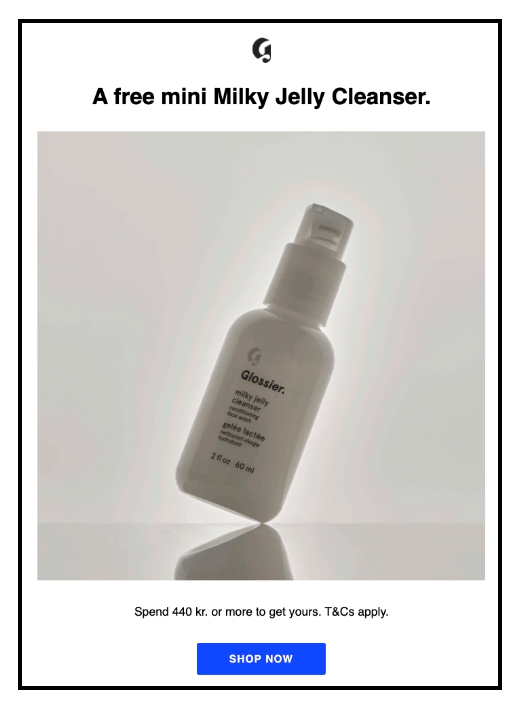
What’s notable about Glossier’s email marketing example:
- Product incentives are proven to have an advantage over traditional discounts as they are more tangible.
- For a consumer, receiving an extra item alongside the order can build more excitement than simply saving a little money.
Tip – Your win-back email could have free shipping, extra loyalty points, and sweepstakes with limited time offers to add urgency to the mix.
8) Cross-sell and up-sell email campaigns from Athletic Greens
It’s a proven fact that selling to an existing customer is way easier than acquiring a new one because of the time and money involved. That’s why upselling and cross-selling are valuable for any Ecommerce or DTC business to boost their email conversion rates.
Upselling means you encourage customers to purchase higher-end and more expensive products than their previous purchase. Cross-selling encourages them to buy products related to the ones they bought. Both concepts work because of the trust and loyalty of the customers in their brands.
While upselling or cross-selling through email campaigns recommend products that are related to the already purchased items to make your emails more relevant and impactful.
Example
An example of upselling email is from Athletic Greens which produces nutritional supplements and superfoods green powder. This email offers readers the option to upgrade to a subscription model and save $20 each month with many extra benefits.
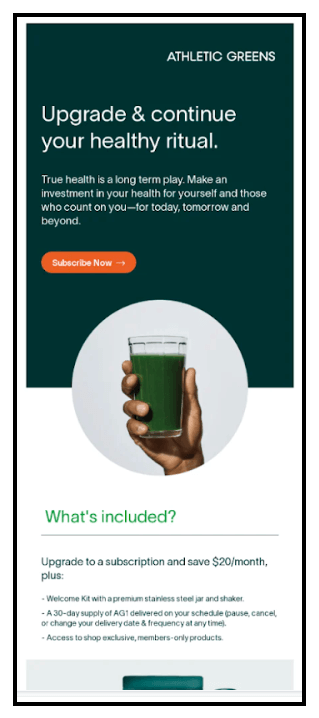
Tip – One thing for your Ecommerce or DTC brand is to list the product benefits, but having customers say it for you packs a bigger punch. For a potential customer, knowing what other customers think of your products may tip the scales enough to nudge them to buy your product.
9) Reward Email Campaign from Smash + Tess
Rewarding customers through a rewards program is a definite way to build customer loyalty and generate more sales and turn them into brand evangelists.
The reward-based DTC email campaign is an effective way to let customers who already trust your brand, join a loyalty rewards program. This Ecommerce drip campaign type definitely helps to keep them coming back to your brand instead of being poached by your competitors.
Here are some pointers to include in your rewards email campaigns:
- Make rewards benefits easy to understand
- Talk about the different ways to earn rewards
- Link popular product categories in these emails
- Combine product promotions with rewards
A whopping 52% of customers say that they would willingly join a brand’s rewards program for which they feel loyalty.
Example
Here’s an example of a rewards program email campaign from Smash + Tess.
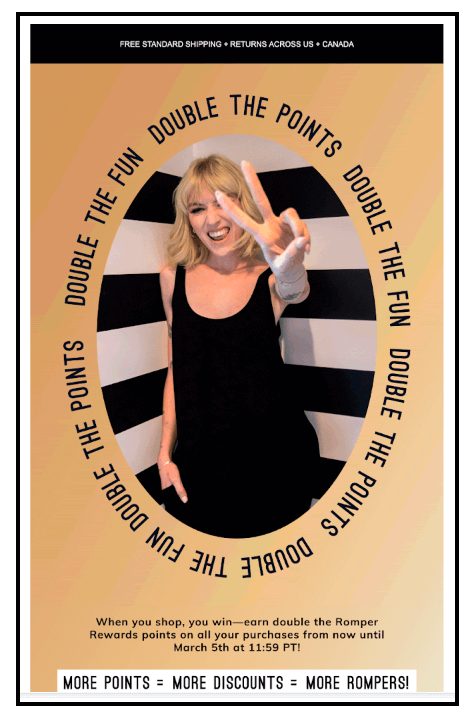
Why is this a great DTC email campaign example?
- Their messaging is very clear: Customers can earn double the points and get greater discounts and these can be cashed for more products (rompers in this case).
- There is a clear CTA to join the loyalty program.
Tip – If you are running a loyalty program or rewards program campaign, then promoting it is the key to the success of your DTC email marketing campaign.
10) Post-purchase review email campaign from Ring
In Ecommerce and DTC, your work is not over after you’ve sold your product. Gaining feedback about the shopping experience and the product is of utmost importance to know whether customers are satisfied or if something is bothering them.
Almost 95% of customers read reviews before they purchase a product which makes it an important sales tactic for your business.
Sending a post-purchase review email campaign after the customer has presumably used the product makes it easy to garner customer feedback and figure out ways of improving the experience for future customers.
You can include the feedback survey in the email campaign itself. Directing them to the store is another Ecommerce email marketing strategy to prompt satisfied customers to check out more products after reviewing the purchase.
Tell the customers why you are asking for their opinion and how you plan to include their feedback.
Example
An example of a post-purchase review email campaign is from Ring, a DTC brand that sells doorbells, security cameras, alarms, and more.
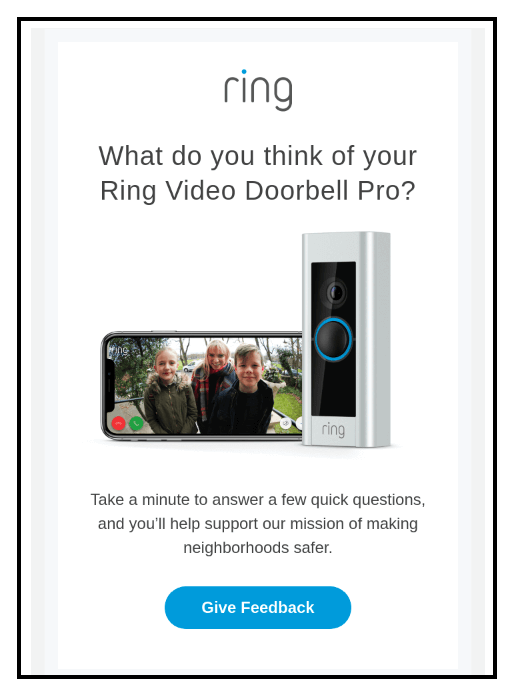
Why does Ring’s post-purchase feedback DTC email campaign stand out?
- Take note of how they say “Take a minute to answer a few questions to support our mission of making neighborhoods safer”. It is a convincing way to get customers to take part in the survey.
- Emphasize how customer feedback helps improve the product and the impact it would have on the bigger scheme of things.
Tip – In addition to this, another way of ensuring customers share their feedback is to make the process simple and quick. Since your customers don’t want to spend too much time answering the survey, you could use a one-question or Net Promoter Score survey.
Wrapping up…
There you have it…ten best email campaign examples from successful DTC and Ecommerce brands. If you are looking for the best DTC email marketing examples, these ideas are a great starting point.
You can supercharge your email marketing strategy by getting inspired by the above email campaign examples.
You may also like
Essential resources for your success
